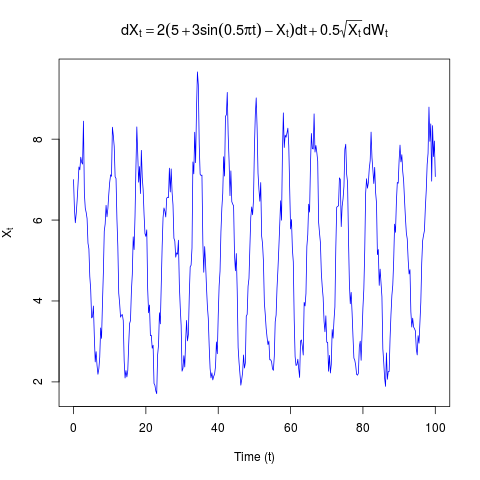Supported by Dr. Osamu Ogasawara and  providing providing  . . |
|
Last data update: 2014.03.03 |
MLEs for Generalized Quadratic Diffusion Models (GQDs).Description
where
and
Usage
GQD.mle(X, time, mesh=10, theta, control=NULL, method='Nelder-Mead', Dtype='Saddle',
Trunc=c(4,4), RK.order=4, P=200, alpha=0, lower=min(X)/2, upper=max(X)*2,
exclude=NULL, Tag=NA, wrt=FALSE, print.output=TRUE)
Arguments
Value
Syntactical jargonSynt. [1]: The coefficients of the GQD may be parameterized using the reserved variable
Synt. [2]: Due to syntactical differences between R and C++ special functions have to be used when terms that depend on
Here sqrt(t)*cos(3*pi*t) constitutes the product of two terms that cannot be written i.t.o. a single Synt. [3]: Similarly, the ^ - operator is not overloaded in C++. Instead the
WarningWarning [1]: The parameter Warning [2]: Note that minus the likelihood is minimized, as such the Author(s)Etienne A.D. Pienaar: etiennead@gmail.com ReferencesUpdates available on GitHub at https://github.com/eta21. Daniels, H.E. 1954 Saddlepoint approximations in statistics. Ann. Math. Stat., 25:631–650. Eddelbuettel, D. and Romain, F. 2011 Rcpp: Seamless R and C++ integration. Journal of Statistical Software, 40(8):1–18,. URL http://www.jstatsoft.org/v40/i08/. Eddelbuettel, D. 2013 Seamless R and C++ Integration with Rcpp. New York: Springer. ISBN 978-1-4614-6867-7. Eddelbuettel, D. and Sanderson, C. 2014 Rcpparmadillo: Accelerating R with high-performance C++ linear algebra. Computational Statistics and Data Analysis, 71:1054–1063. URL http://dx.doi.org/10.1016/j.csda.2013.02.005. Feagin, T. 2007 A tenth-order Runge-Kutta method with error estimate. In Proceedings of the IAENG Conf. on Scientifc Computing. Varughese, M.M. 2013 Parameter estimation for multivariate diffusion systems. Comput. Stat. Data An., 57:417–428. See Also
Examples
#===============================================================================
# Simulate a time inhomogeneous diffusion.
#-------------------------------------------------------------------------------
data(SDEsim1)
attach(SDEsim1)
par(mfrow=c(1,1))
expr1=expression(dX[t]==2*(5+3*sin(0.5*pi*t)-X[t])*dt+0.5*sqrt(X[t])*dW[t])
plot(Xt~time,type='l',col='blue',xlab='Time (t)',ylab=expression(X[t]),main=expr1)
#------------------------------------------------------------------------------
# Define coefficients of the process.
#------------------------------------------------------------------------------
GQD.remove()
G0 <- function(t){theta[1]*(theta[2]+theta[3]*sin(0.25*pi*t))}
G1 <- function(t){-theta[1]}
Q0 <- function(t){theta[4]*theta[4]}
theta.start <- c(1,1,1,1) # Starting values for the chain
mesh.points <- 10 # Number of mesh points
m1 <- GQD.mle(Xt,time,mesh=mesh.points,theta=theta.start)
GQD.remove()
G0 <- function(t){theta[1]*(theta[2]+theta[3]*sin(0.25*pi*t))}
G1 <- function(t){-theta[1]}
Q1 <- function(t){theta[4]*theta[4]}
theta.start <- c(1,1,1,1) # Starting values for the chain
mesh.points <- 10 # Number of mesh points
m2 <- GQD.mle(Xt,time,mesh=mesh.points,theta=theta.start)
# Check estimates:
GQD.estimates(m1)
GQD.estimates(m2)
# Compare models:
GQD.aic(list(m1,m2))
#===============================================================================
Results
R version 3.3.1 (2016-06-21) -- "Bug in Your Hair"
Copyright (C) 2016 The R Foundation for Statistical Computing
Platform: x86_64-pc-linux-gnu (64-bit)
R is free software and comes with ABSOLUTELY NO WARRANTY.
You are welcome to redistribute it under certain conditions.
Type 'license()' or 'licence()' for distribution details.
R is a collaborative project with many contributors.
Type 'contributors()' for more information and
'citation()' on how to cite R or R packages in publications.
Type 'demo()' for some demos, 'help()' for on-line help, or
'help.start()' for an HTML browser interface to help.
Type 'q()' to quit R.
> library(DiffusionRgqd)
> png(filename="/home/ddbj/snapshot/RGM3/R_CC/result/DiffusionRgqd/GQD.mle.Rd_%03d_medium.png", width=480, height=480)
> ### Name: GQD.mle
> ### Title: MLEs for Generalized Quadratic Diffusion Models (GQDs).
> ### Aliases: GQD.mle
> ### Keywords: syntax C++ maximum likelihood
>
> ### ** Examples
>
> ## No test:
> #===============================================================================
> # Simulate a time inhomogeneous diffusion.
> #-------------------------------------------------------------------------------
>
> data(SDEsim1)
> attach(SDEsim1)
> par(mfrow=c(1,1))
> expr1=expression(dX[t]==2*(5+3*sin(0.5*pi*t)-X[t])*dt+0.5*sqrt(X[t])*dW[t])
> plot(Xt~time,type='l',col='blue',xlab='Time (t)',ylab=expression(X[t]),main=expr1)
>
> #------------------------------------------------------------------------------
> # Define coefficients of the process.
> #------------------------------------------------------------------------------
>
> GQD.remove()
[1] "Removed : NA "
> G0 <- function(t){theta[1]*(theta[2]+theta[3]*sin(0.25*pi*t))}
> G1 <- function(t){-theta[1]}
> Q0 <- function(t){theta[4]*theta[4]}
>
> theta.start <- c(1,1,1,1) # Starting values for the chain
> mesh.points <- 10 # Number of mesh points
>
> m1 <- GQD.mle(Xt,time,mesh=mesh.points,theta=theta.start)
Compiling C++ code. Please wait.
================================================================
Generalized Ornstein-Uhlenbeck
================================================================
_____________________ Drift Coefficients _______________________
G0 : theta[1]*(theta[2]+theta[3]*sin(0.25*pi*t))
G1 : -theta[1]
G2
___________________ Diffusion Coefficients _____________________
Q0 : theta[4]*theta[4]
Q1
Q2
_______________________ Model/Chain Info _______________________
Time Homogeneous : No
Data Resolution : Homogeneous: dt=0.25
# Removed Transits. : None
Density approx. : 2nd Ord. Truncation + Std Normal Dist.
Elapsed time : 00:00:00
... ... ... ... ... ... ... ... ... ... ...
dim(theta) : 4
----------------------------------------------------------------
>
> GQD.remove()
[1] "Removed : G0 G1 Q0"
>
> G0 <- function(t){theta[1]*(theta[2]+theta[3]*sin(0.25*pi*t))}
> G1 <- function(t){-theta[1]}
> Q1 <- function(t){theta[4]*theta[4]}
>
> theta.start <- c(1,1,1,1) # Starting values for the chain
> mesh.points <- 10 # Number of mesh points
>
> m2 <- GQD.mle(Xt,time,mesh=mesh.points,theta=theta.start)
Compiling C++ code. Please wait.
================================================================
Generalized Quadratic Diffusion (GQD)
================================================================
_____________________ Drift Coefficients _______________________
G0 : theta[1]*(theta[2]+theta[3]*sin(0.25*pi*t))
G1 : -theta[1]
G2
___________________ Diffusion Coefficients _____________________
Q0
Q1 : theta[4]*theta[4]
Q2
_______________________ Model/Chain Info _______________________
Time Homogeneous : No
Data Resolution : Homogeneous: dt=0.25
# Removed Transits. : None
Density approx. : 4 Ord. Truncation +4th Ord. Saddlepoint Appr.
Elapsed time : 00:00:00
... ... ... ... ... ... ... ... ... ... ...
dim(theta) : 4
----------------------------------------------------------------
>
> # Check estimates:
> GQD.estimates(m1)
Estimate Lower_95 Upper_95
theta[1] 2.087 1.805 2.369
theta[2] 5.016 4.907 5.124
theta[3] 2.898 2.737 3.059
theta[4] 1.138 1.052 1.223
> GQD.estimates(m2)
Estimate Lower_95 Upper_95
theta[1] 2.036 1.773 2.299
theta[2] 5.014 4.906 5.121
theta[3] 2.911 2.756 3.066
theta[4] 0.498 0.460 0.535
>
> # Compare models:
> GQD.aic(list(m1,m2))
Convergence p min.likelihood AIC BIC N
Model 1 0 4 246.5406 501.0812 517.0570 401
Model 2 0 4 225.0633 [=] 458.1267 [=] 474.1025 401
>
> #===============================================================================
> ## End(No test)
>
>
>
>
>
> dev.off()
null device
1
>
|



